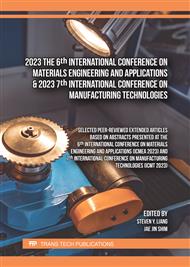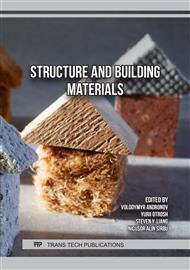[1]
M. L. Van Rensburg, S. L. Nkomo and N. M. Mkhize, "Life cycle and End-of-Life management options in the footwear industry: A review," Waste Management & Research, 2020.
DOI: 10.1177/0734242x20908938
Google Scholar
[2]
M. C. Baptista, M. da Luz Garcia, S. C. Pinho, M. Ascensão Lopes, M. F. Almeida, C. Coelho and C. Fonseca, "Valorization of EVA waste from footwear industry as natural aggregates substitutes in mortar: the effect of granulometry," Journal of Material Cycles and Waste Management, vol. 23, pp.1445-1455, 2021.
DOI: 10.1007/s10163-021-01222-7
Google Scholar
[3]
C. Z. Paiva Junior, R. S. Peruchi, F. d. C. Fim, W. d. O. S. Soares and L. B. da Silva, "Performance of ethylene vinyl acetate waste (EVA-w) when incorporated into expanded EVA foam for footwear," Journal of Cleaner Production, vol. 317, 2021.
DOI: 10.1016/j.jclepro.2021.128352
Google Scholar
[4]
I.Y.I. Elgady, "Recycling of EVA Foam Waste as A Constituent of Lightweight Concrete Mixture for Construction Application," SUST Repository, 2018. [Online]. Available: http://repository.sustech.edu/handle/123456789/20656. [Accessed October 2021].
Google Scholar
[5]
A.M. Farhoud, M. Mansour, R. M. Shoukry, O. E. Bagoury, S. E. Akkad, M. Farag, A. Hamza, E. E. Nahas, A. Hussam and M. N. Abou-Zeid, "Use of EVA Foam in Portland Cement Concrete," Leadership in Sustainable Infrastructure, 2018.
Google Scholar
[6]
F. Pacheco, M. Krumenauer, D.R. de Medeiros, M.F. Oliveira and B.F. Tutikian, "Development of lightweight concrete subfloor with ethylene vinyl acetate (EVA) aggregates waste to reduce impact sound in flooring system," Dyna rev.fac.nac.minas, vol. 84, pp.290-295, 2017.
DOI: 10.15446/dyna.v84n201.61491
Google Scholar
[7]
L.R. Brancher, M.F. d. O. Nunes, A.M.C. Grisa, D.T. Pagnussat and M. Zeni, "Acoustic Behavior of Subfloor Lightweight Mortars Containing Micronized Poly (Ethylene Vinyl Acetate) (EVA)," materials, 2016.
DOI: 10.3390/ma9010051
Google Scholar
[8]
N. Dulsang, P. Kasemsiri, P. Posi, S. Hiziroglu and P. Chindaprasirt, "Characterization of an environment friendly lightweight concrete containing ethyl vinyl acetate waste," Materials & Design, vol. 96, pp.350-356, 2016.
DOI: 10.1016/j.matdes.2016.02.037
Google Scholar
[9]
V. Gregorova and S. Uncik, "Characterization of Lightweight Concrete Produced from Plastics Waste - Polystyrene and EVA," Applied Mechanics and Materials, vol. 861, pp.24-31, 2016.
DOI: 10.4028/www.scientific.net/amm.861.24
Google Scholar
[10]
D.P.R. Abraham, J. Anu, A. Jasheela, B. P.R. and J. Sarma, "Development of Coir-fibre Cement Composite Roofing Tiles," Procedia Technology, vol. 24, pp.169-178, 2016.
DOI: 10.1016/j.protcy.2016.05.024
Google Scholar
[11]
P. Dunckey, Designing effective sand and mortar mixes for Micro Concrete Roof Tile (MCR), EcoSur.
Google Scholar
[12]
G.S. De Silva and M. Mallwattha, "Strength, durability, thermal and run-off properties of fired clay roof tiles incorporated with ceramic sludge," Construction and Building Materials, vol. 179, pp.390-399, 2018.
DOI: 10.1016/j.conbuildmat.2018.05.187
Google Scholar
[13]
"Testing Application Standard (TAS) No. 112-95 Standard Requirements for Concrete Roof Tiles," in 2020 FBC - Test Protocols for HVHZ, 7th edition, 2020.
Google Scholar
[14]
X. Li, T.-C. Ling and K. Hung Mo, "Functions and impacts of plastic/rubber wastes as eco-friendly aggregate in concrete – A review," Construction and Building Materials, vol. 240, 2020.
DOI: 10.1016/j.conbuildmat.2019.117869
Google Scholar
[15]
A.B. Melo and T.N.M. Mendonça, "Cement blocks with EVA waste for extensive modular green roof: contribution of components in thermal insulation," Revista IBRACON de Estruturas e Materiais, vol. 10, pp.92-121, 2017.
DOI: 10.1590/s1983-41952017000100006
Google Scholar



